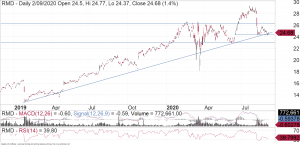ResMed (ASX:RMD) shares fell sharply from its all-time recent high in July 2020 after reporting 4th quarter results (4Q20) that were below market expectations. The last time the share price weakened so sharply was following the release of a quarterly result, 18 months ago, and on that occasion, there was a very quick rebound. While the reasons for the decline 18 months ago are different to those underpinning the most recent sell-off, we consider that there are a number of factors supporting a recovery in the shares this time around.
About ResMed
RMD provides products for the treatment of sleep-related breathing disorders. This includes obstructive sleep apnea (OSA), Chronic Obstructive Pulmonary Disease (COPD), and other respiratory conditions. The product portfolio has traditionally included airflow generators, nasal masks, and pillows that introduce airflow. The acquisition of Brightree in April 2016 expanded the Company’s operations to include the supply of business management software solutions to medical equipment and home health providers in the US. The Company now has three reporting lines by product: Masks, Devices, and Software-as-a-Solution (SaaS). The key geographic exposures are classified as ‘Americas’ (mostly the US) and ‘Rest of the World’ (ROW).
Why the selloff in shares?
Revenue growth of 9% was supported by a large increase in COVID-19-related ventilator sales. However, this was below expectations as a result of lower-than-expected sales growth across in Americas (Devices + Masks) and ROW masks.
Further, the expansion in gross profit margin (a key measure of financial performance) was lower than expected. While gross profit margin benefited from sales mix (i.e. increased ventilator production), it was impacted by declines in manufacturing and procurement efficiencies driven by higher air freight costs.
On the other hand, EBIT (+24%) was above expectations due to strong ventilator device sales and controlled operating costs.
Implications from Changing Revenue Growth Expectations for OSA & Ventilators
The main headwind over the short-to-medium term is weighing up an expected sharp tapering of ventilator demand (10-15% of group revenue) against a steady recovery in OSA (85-90% of group revenue) through the coming quarters.
Although new patient starts are faring better than in-patient sleep laboratories, (i.e. down by ~15-20% in US, compared to sleep laboratories which are down 30% in the US and down 50% in China), the recovery appears to be slower than expected. This creates a mismatch over the course of FY21, whereby the recovery in OSA does not compensate quickly enough for the loss of ventilator demand.
Modest group revenue growth is expected in the near term, on the back of lower ventilator sales, and significantly lower COVID-19 volumes coupled with a gradual recovery in new OSA patients.
Fundamental View
The shares now trading on a 1-year forward P/E multiple of ~37x, having de-rated from ~45x prior to the 4Q20 results release. While the current multiple is above the 2-year average of ~33x, we expect the shares will quickly regain its premium rating. Key factors supporting our view include:
• There is scope for earnings improvement in FY21 despite modest revenue growth outlook. Given expectations for modest revenue growth coupled with flattish gross profit margin in FY21, EPS growth for FY21 is expected to be down by ~1%, according to consensus estimates. The key upside risk to this is lower operating expenditure, given that RMD has a history of key cost items trending down over time. EPS growth forecasts for FY22 (+11%) factor in a recovery in new OSA patients back to pre-COVID levels, continued operating cost control.
• Notwithstanding the curtailed contribution from higher-margin ventilation sales and short-term pressures from limited in-laboratory sleep diagnostics, we consider that the fundamental drivers of longer-term growth remain intact. RMD’s increased investment in its out-of-hospital platforms, means it is well placed to benefit from any behavioural shift post COVID-19, with potentially greater demand for home healthcare. To this end, RMD has a large focus on digital health, which has accelerated in light of COVID-19.
• Strong free cashflow generation is expected to result in the balance sheet becoming net cash in FY22. In turn, this provides the Company with significant balance sheet flexibility to undertake initiatives such as higher dividend payments, share buybacks or strategic investments.
Charting View
Although the decline in the share price after the result was quite sharp, we don’t view that as a negative. This is because swift moves after results are part of RMD’s personality. The longer term uptrend is still in place. RMD shares have found support in the last few weeks on the longer term trend line and the gap from June. Current levels therefore represent a buying opportunity. If current levels don’t hold in the short term, then the next support level is close-by at $23. Otherwise we expect RMD shares to maybe use up a bit more time here and then start trending higher again.





